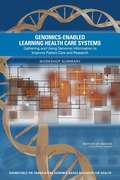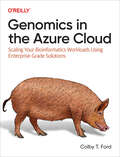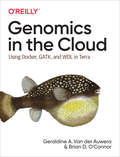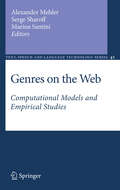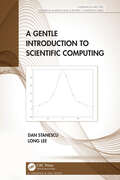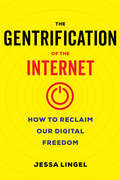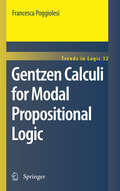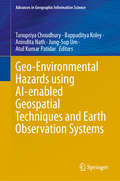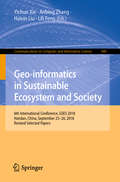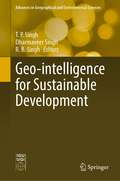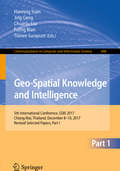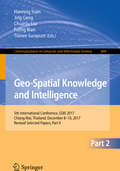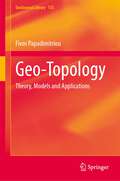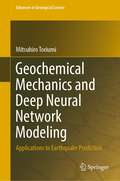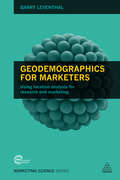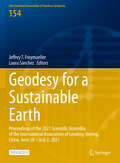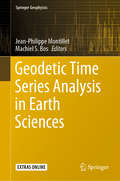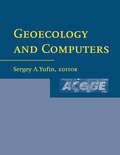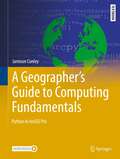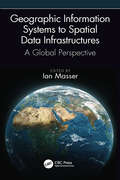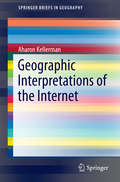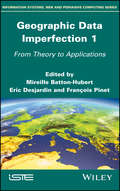- Table View
- List View
Genomics and Bioinformatics
by Tore SamuelssonWith the arrival of genomics and genome sequencing projects, biology has been transformed into an incredibly data-rich science. The vast amount of information generated has made computational analysis critical and has increased demand for skilled bioinformaticians. Designed for biologists without previous programming experience, this textbook provides a hands-on introduction to Unix, Perl and other tools used in sequence bioinformatics. Relevant biological topics are used throughout the book and are combined with practical bioinformatics examples, leading students through the process from biological problem to computational solution. All of the Perl scripts, sequence and database files used in the book are available for download at the accompanying website, allowing the reader to easily follow each example using their own computer. Programming examples are kept at an introductory level, avoiding complex mathematics that students often find daunting. The book demonstrates that even simple programs can provide powerful solutions to many complex bioinformatics problems.
Genomics-Enabled Learning Health Care Systems: Workshop Summary
by Sarah H. BeachyThe inclusion of genomic data in a knowledge-generating health care system infrastructure is one promising way to harness the full potential of that information to provide better patient care. In such a system, clinical practice and research influence each other with the goal of improving the efficiency and effectiveness of disease prevention, diagnosis, and treatment. To examine pragmatic approaches to incorporating genomics in learning health care systems, the Institute of Medicine Roundtable on Translating Genomic-Based Research for Health hosted a workshop which convened a variety of stakeholder groups, including commercial developers, health information technology professionals, clinical providers, academic researchers, patient groups, and government and health system representatives, to present their perspectives and participate in discussions on maximizing the value that can be obtained from genomic information. The workshop examined how a variety of systems are capturing and making use of genomic data to generate knowledge for advancing health care in the 21st century. It also sought to evaluate the challenges, opportunities, and best practices for capturing or using genomic information in knowledge-generating health care systems. "Genomics-Enabled Learning Health Care Systems" summarizes the presentations and discussion of the workshop.
Genomics-Enabled Learning Health Care Systems: Workshop Summary
by Sarah H. BeachyThe inclusion of genomic data in a knowledge-generating health care system infrastructure is one promising way to harness the full potential of that information to provide better patient care. In such a system, clinical practice and research influence each other with the goal of improving the efficiency and effectiveness of disease prevention, diagnosis, and treatment. To examine pragmatic approaches to incorporating genomics in learning health care systems, the Institute of Medicine Roundtable on Translating Genomic-Based Research for Health hosted a workshop which convened a variety of stakeholder groups, including commercial developers, health information technology professionals, clinical providers, academic researchers, patient groups, and government and health system representatives, to present their perspectives and participate in discussions on maximizing the value that can be obtained from genomic information. The workshop examined how a variety of systems are capturing and making use of genomic data to generate knowledge for advancing health care in the 21st century. It also sought to evaluate the challenges, opportunities, and best practices for capturing or using genomic information in knowledge-generating health care systems. Genomics-Enabled Learning Health Care Systems summarizes the presentations and discussion of the workshop.
Genomics in the Azure Cloud
by Colby T. FordThis practical guide bridges the gap between general cloud computing architecture in Microsoft Azure and scientific computing for bioinformatics and genomics. You'll get a solid understanding of the architecture patterns and services that are offered in Azure and how they might be used in your bioinformatics practice. You'll get code examples that you can reuse for your specific needs. And you'll get plenty of concrete examples to illustrate how a given service is used in a bioinformatics context.You'll also get valuable advice on how to:Use enterprise platform services to easily scale your bioinformatics workloadsOrganize, query, and analyze genomic data at scaleBuild a genomics data lake and accompanying data warehouseUse Azure Machine Learning to scale your model training, track model performance, and deploy winning modelsOrchestrate and automate processing pipelines using Azure Data Factory and DatabricksCloudify your organization's existing bioinformatics pipelines by moving your workflows to Azure high-performance compute servicesAnd more
Genomics in the Cloud: Using Docker, GATK, and WDL in Terra
by Brian O'Connor Geraldine A. Van der AuweraData in the genomics field is booming. In just a few years, organizations such as the National Institutes of Health (NIH) will host 50+ petabytes—or over 50 million gigabytes—of genomic data, and they’re turning to cloud infrastructure to make that data available to the research community. How do you adapt analysis tools and protocols to access and analyze that volume of data in the cloud?With this practical book, researchers will learn how to work with genomics algorithms using open source tools including the Genome Analysis Toolkit (GATK), Docker, WDL, and Terra. Geraldine Van der Auwera, longtime custodian of the GATK user community, and Brian O’Connor of the UC Santa Cruz Genomics Institute, guide you through the process. You’ll learn by working with real data and genomics algorithms from the field. <p><p>This book covers: <li>Essential genomics and computing technology background <li>Basic cloud computing operations <li>Getting started with GATK, plus three major GATK Best Practices pipelines <li>Automating analysis with scripted workflows using WDL and Cromwell <li>Scaling up workflow execution in the cloud, including parallelization and cost optimization <li>Interactive analysis in the cloud using Jupyter notebooks <li>Secure collaboration and computational reproducibility using Terra
Genres on the Web
by Serge Sharoff Marina Santini Alexander MehlerThe volume "Genres on the Web" has been designed for a wide audience, from the expert to the novice. It is a required book for scholars, researchers and students who want to become acquainted with the latest theoretical, empirical and computational advances in the expanding field of web genre research. The study of web genre is an overarching and interdisciplinary novel area of research that spans from corpus linguistics, computational linguistics, NLP, and text-technology, to web mining, webometrics, social network analysis and information studies. This book gives readers a thorough grounding in the latest research on web genres and emerging document types. The book covers a wide range of web-genre focused subjects, such as: * The identification of the sources of web genres * Automatic web genre identification * The presentation of structure-oriented models * Empirical case studies One of the driving forces behind genre research is the idea of a genre-sensitive information system, which incorporates genre cues complementing the current keyword-based search and retrieval applications.
A Gentle Introduction to Optimization
by B. Guenin J. Könemann L. TunçelOptimization is an essential technique for solving problems in areas as diverse as accounting, computer science and engineering. Assuming only basic linear algebra and with a clear focus on the fundamental concepts, this textbook is the perfect starting point for first- and second-year undergraduate students from a wide range of backgrounds and with varying levels of ability. Modern, real-world examples motivate the theory throughout. The authors keep the text as concise and focused as possible, with more advanced material treated separately or in starred exercises. Chapters are self-contained so that instructors and students can adapt the material to suit their own needs and a wide selection of over 140 exercises gives readers the opportunity to try out the skills they gain in each section. Solutions are available for instructors. The book also provides suggestions for further reading to help students take the next step to more advanced material.
A Gentle Introduction to Scientific Computing (Chapman & Hall/CRC Numerical Analysis and Scientific Computing Series)
by Dan Stanescu Long LeeScientific Computation has established itself as a stand-alone area of knowledge in the border area between computer science and applied mathematics. Nonetheless, its interdisciplinary character cannot be denied: its methodologies are increasingly used in a wide variety of branches of science and engineering. A Gentle Introduction to Scientific Computing intends to serve a very broad audience of college students across a variety of disciplines. It aims to expose its readers to some of the basic tools and techniques used in computational science, with a view to helping them understand what happens ‘behind the scenes’ when simple tools such as solving equations, plotting and interpolation are used. To make the book as practical as possible, the authors explore their subject both from a theoretical, mathematical perspective and from an implementation-driven, programming perspective. Features Takes a middle ground approach between theoretical book and implementation Suitable reading for a broad range of students in STEM disciplines, and could be the primary text for a first course in scientific computing Introduces mathematics majors, without any prior computer science exposure, to numerical methods All mathematical knowledge needed beyond Calculus (and the more useful Calculus notation and concepts) is introduced in the text to make it self-contained.
The Gentrification of the Internet: How to Reclaim Our Digital Freedom
by Jessa LingelHow we lost control of the internet—and how to win it back. The internet has become a battleground. Although it was unlikely to live up to the hype and hopes of the 1990s, only the most skeptical cynics could have predicted the World Wide Web as we know it today: commercial, isolating, and full of, even fueled by, bias. This was not inevitable. The Gentrification of the Internet argues that much like our cities, the internet has become gentrified, dominated by the interests of business and capital rather than the interests of the people who use it. Jessa Lingel uses the politics and debates of gentrification to diagnose the massive, systemic problems blighting our contemporary internet: erosions of privacy and individual ownership, small businesses wiped out by wealthy corporations, the ubiquitous paywall. But there are still steps we can take to reclaim the heady possibilities of the early internet. Lingel outlines actions that internet activists and everyday users can take to defend and secure more protections for the individual and to carve out more spaces of freedom for the people—not businesses—online.
Gentzen Calculi for Modal Propositional Logic
by Francesca PoggiolesiThe book is about Gentzen calculi for (the main systems of) modal logic. It is divided into three parts. In the first part we introduce and discuss the main philosophical ideas related to proof theory, and we try to identify criteria for distinguishing good sequent calculi. In the second part we present the several attempts made from the 50's until today to provide modal logic with Gentzen calculi. In the third and and final part we analyse new calculi for modal logics, called tree-hypersequent calculi, which were recently introduced by the author. We show in a precise and clear way the main results that can be proved with and about them.
Geo-Environmental Hazards using AI-enabled Geospatial Techniques and Earth Observation Systems (Advances in Geographic Information Science)
by Jung-Sup Um Tanupriya Choudhury Bappaditya Koley Anindita Nath Atul Kumar PatidarThis edited collection provides a comprehensive exploration of cutting-edge ideas, approaches, simulations, evaluations of risk, and systems that enhance the practicality of current geospatial technologies for reducing hazard risks. The various sections within this book delve into subjects such as the foundational principles of Earth Observation Systems (EOS) and geospatial methodologies. Additionally, the text serves as an advisory resource on the collaborative use of satellite-derived data and artificial intelligence to track and alleviate geo-environmental threats. The volume imparts extensive understanding regarding geo-environmental dangers and their analysis via EOS along with geospatial strategies. It encompasses key hazard-related themes including coastal degradation, predisposition to landslides, mapping vegetation coverages, tropical storm patterns, soil depletion due to erosion processes, vulnerability to rapid or extended flooding events, variations in oceansurface temperatures alongside chlorophyll-a levels; it also addresses assessments related to groundwater reserves and quality measures as well as sustainable management practices for watersheds that support community livelihoods—all through leveraging AI-integrated geospatial tools in conjunction with earth observation technologies. Furthermore, this work engages in discourse about systems designed for mitigating these ecological challenges sustainably. Scholars engaged in research activities; educational professionals; those involved in landscape design; engineers working at ground level; individuals responsible for policy-making—all who are concerned with geo-environmental hazards or associated domains—will find valuable insights within these pages.
Geo-informatics in Sustainable Ecosystem and Society: 6th International Conference, GSES 2018, Handan, China, September 25–26, 2018, Revised Selected Papers (Communications in Computer and Information Science #980)
by Yichun Xie Anbing Zhang Haixin Liu Lili FengThis book constitutes the refereed proceedings of the 6th International Conference on Geo-informatics in Sustainable Ecosystem and Society, GSES 2018, held in Handan, China, in September 2018. The 46 papers presented in this volume were carefully reviewed and selected from 153 submissions and focus on spatial data acquisition, processing and management, modeling and analysis, and recent applications in the context of building healthier ecology and resource management using advanced remote sensing technology and spatial data modeling and analysis.
Geo-intelligence for Sustainable Development (Advances in Geographical and Environmental Sciences)
by T. P. Singh Dharmaveer Singh R. B. SinghGlobally, concerns for the environment and human well-being have increased as results of threats imposed by climate change and disasters, environmental degradation, pollution of natural resources, water scarcity and proliferation of slums. Finding appropriate solutions to these threats and challenges is not simple, as these are generally complex and require state-of-the-art technology to collect, measure, handle and analyse large volumes of varying data sets. However, the recent advances in sensor technology, coupled with the rapid development of computational power, have greatly enhanced our abilities to capture, store and analyse the surrounding physical environment. This book explores diverse dimensions of geo-intelligence (GI) technology in developing a computing framework for location-based, data-integrating earth observation and predictive modelling to address these issues at all levels and scales. The book provides insight into the applications of GI technology in several fields of spatial and social sciences and attempts to bridge the gap between them.
Geo-Spatial Knowledge and Intelligence: 5th International Conference, GSKI 2017, Chiang Mai, Thailand, December 8-10, 2017, Revised Selected Papers, Part I (Communications in Computer and Information Science #848)
by Fuling Bian Hanning Yuan Jing Geng Chuanlu Liu Tisinee SurapuntThis two-volume set (CCIS 848 and CCIS 849) constitutes the thoroughly refereed proceedings of the 5th International Conference Geo-Spatial Knowledge and Intelligence, GSKI 2017, held in Chiang Mai, Thailand, in December 2018.The 142 full papers presented were carefully reviewed and selected from 579 submissions. They are organized in topical sections on smart city in resource management and sustainable ecosystem; spatial data acquisition through RS and GIS in resource management and sustainable ecosystem; ecological and environmental data processing and management; advanced geospatial model and analysis for understanding ecological and environmental process; applications of geo-informatics in resource management and sustainable ecosystem.
Geo-Spatial Knowledge and Intelligence: 5th International Conference, GSKI 2017, Chiang Mai, Thailand, December 8-10, 2017, Revised Selected Papers, Part II (Communications in Computer and Information Science #849)
by Fuling Bian Hanning Yuan Jing Geng Chuanlu Liu Tisinee SurapuntThis two-volume set (CCIS 848 and CCIS 849) constitutes the thoroughly refereed proceedings of the 5th International Conference Geo-Spatial Knowledge and Intelligence, GSKI 2017, held in Chiang Mai, Thailand, in December 2018.The 142 full papers presented were carefully reviewed and selected from 579 submissions. They are organized in topical sections on smart city in resource management and sustainable ecosystem; spatial data acquisition through RS and GIS in resource management and sustainable ecosystem; ecological and environmental data processing and management; advanced geospatial model and analysis for understanding ecological and environmental process; applications of geo-informatics in resource management and sustainable ecosystem.
Geo-Topology: Theory, Models and Applications (GeoJournal Library #133)
by Fivos PapadimitrouGeo-Topology is an exploration of the depth and breadth of the relationships between Geography and Topology, with applications ranging from Landscape Geography to Social Geography and from Spatial Analysis to Geospatial Technologies. It shows how topics of geographical research (landscapes, borders, spatial social relationships etc) can be examined by using mathematical concepts and methods of Topology, exposing the realm of geo-topological modelling and visualization through Point-Set Topology, Knot Theory, Reeb graphs, Topological Surfaces (i.e. Möbius bands and Klein bottles), Differential Topology, Network Analysis, Combinatorial Topology, Braid Theory and Ultrametric Topology. Besides geographers, this book is a trove of new ideas for landscape ecologists, mathematicians, data scientists, sociologists, psychologists, anthropologists and educators. Geo-Topology is a systematic introduction to topological thinking in Geography, also by highlighting the significance of Topology for Geographical Education, as well as for the Philosophy and Epistemology of Geography.
Geochemical Mechanics and Deep Neural Network Modeling: Applications to Earthquake Prediction (Advances in Geological Science)
by Mitsuhiro ToriumiThe recent understandings about global earth mechanics are widely based on huge amounts of monitoring data accumulated using global networks of precise seismic stations, satellite monitoring of gravity, very large baseline interferometry, and the Global Positioning System. New discoveries in materials sciences of rocks and minerals and of rock deformation with fluid water in the earth also provide essential information. This book presents recent work on natural geometry, spatial and temporal distribution patterns of various cracks sealed by minerals, and time scales of their crack sealing in the plate boundary. Furthermore, the book includes a challenging investigation of stochastic earthquake prediction testing by means of the updated deep machine learning of a convolutional neural network with multi-labeling of large earthquakes and of the generative autoencoder modeling of global correlated seismicity. Their manifestation in this book contributes to the development of human society resilient from natural hazards. Presented here are (1) mechanics of natural crack sealing and fluid flow in the plate boundary regions, (2) large-scale permeable convection of the plate boundary, (3) the rapid process of massive extrusion of plate boundary rocks, (4) synchronous satellite gravity and global correlated seismicity, (5) Gaussian network dynamics of global correlated seismicity, and (6) prediction testing of plate boundary earthquakes by machine learning and generative autoencoders.
Geodemographics for Marketers
by Barry LeventhalGeodemographics, the process of analyzing survey data to profile economic and demographic characteristics of populations, is a successful data-driven analysis tool for marketers. Geodemographic classifications are widely embedded in customer databases and market research datasets. Written by a leading UK authority on geodemographics, Geodemographics for Marketers provides marketers with the know-how to leverage it as an effective research tool to identify location-based segments for highly targeted marketing. International in scope and impartial in its approach, this book demonstrates how to implement geodemographics techniques for practical application in retail, financial services and telecommunications as well as the public sector. Geodemographics for Marketers includes numerous case studies, from the automotive, retail and telecommunications sectors to the public sector, that illustrate core concepts and how they can be applied to gain positive results. The book also incorporates the newly introduced generation of classifications, as well as a discussion of the key decisions of the proposed 2021 census.
Geodesy for a Sustainable Earth: Proceedings of the 2021 Scientific Assembly of the International Association of Geodesy, Beijing, China, June 28 – July 2, 2021 (International Association of Geodesy Symposia #154)
by Jeffrey T. Freymueller Laura SánchezThis open access volume contains selected papers of the 2021 Scientific Assembly of the International Association of Geodesy – IAG2021. The Assembly was hosted by the Chinese Society for Geodesy, Photogrammetry and Cartography (CSGPC) in Beijing, China from June 28 to July 2, 2021. It was a hybrid conference with in-person and online attendants. In total, the Assembly was attended by 146 in-person participants and 1,123 online participants. The theme of the Assembly was Geodesy for a Sustainable Earth. 613 contributions (255 oral presentations and 358 poster presentations) covered all topics of the broad spectrum considered by the IAG: geodetic reference frames, Earth gravity field modelling, Earth rotation and geodynamics, positioning and applications, the Global Geodetic Observing System (GGOS), geodesy for climate research, marine geodesy, and novel sensors and quantum technology for geodesy. All published papers were peer-reviewed, and we warmly recognize the contributions and support of the Associate Editors and Reviewers.
Geodetic Time Series Analysis in Earth Sciences (Springer Geophysics)
by Jean-Philippe Montillet Machiel S. BosThis book provides an essential appraisal of the recent advances in technologies, mathematical models and computational software used by those working with geodetic data. It explains the latest methods in processing and analyzing geodetic time series data from various space missions (i.e. GNSS, GRACE) and other technologies (i.e. tide gauges), using the most recent mathematical models. The book provides practical examples of how to apply these models to estimate seal level rise as well as rapid and evolving land motion changes due to gravity (ice sheet loss) and earthquakes respectively. It also provides a necessary overview of geodetic software and where to obtain them.
Geoecology and Computers
by Sergey A. YufinThis volume presents technical papers devoted to development and practical use of computer methods in geotechnical and geoenviromental engineering. It covers issues on space use and construction, soil and rock mechanics, and mining applications amongst other topics.
A Geographer's Guide to Computing Fundamentals: Python in ArcGIS Pro (Springer Textbooks in Earth Sciences, Geography and Environment)
by Jamison ConleyThis upper-undergraduate textbook teaches students programming in GIS using a mix of computer science theory and hands-on activities, with the aim of empowering students to understand fundamentals and apply their knowledge beyond the specific examples in the book. Each of the book’s twenty-one chapters integrates instructional material with exercises in ArcGIS Pro. In doing so, this book combines the strengths of workbooks and theoretical textbooks to provide a holistic and comprehensive text. Each chapter concludes with an unguided task that ensures students have learned the broader principles explained therein. In addition to its unique format, the book covers oft-neglected topics such as debugging, creating a program from scratch, and managing metadata. Section I starts with the principles of scripting and programming with Python. Section II introduces the ArcPy module and elements specific to ArcGIS Pro. This section focuses on data structures, and how they are used and implemented within Python. Section III uses the topic of algorithms to guide the student through creating tools to add functionality to ArcGIS Pro. The last section, Section IV, builds upon section III to guide the student to developing and sharing projects and Python packages to include external open-source code and share the Python code as an open-source package. This text will prepare students for a long-term ability to do GIS programming, whether in industry or academic research. This comes from the author’s observations of students who have learned GIS programming in one platform, such as VBA in ArcMap, struggle to apply that knowledge to a new platform, such as Python in ArcGIS Pro, because the content was presented too closely with a specific platform. The integration of exercises with conceptual content, along with the choice of chapter content, serves this goal of preparing students for working in a dynamic, rapidly changing technology field.
Geographic Information Systems to Spatial Data Infrastructures: A Global Perspective
by Ian MasserThis book draws on author’s wealth of knowledge working on numerous projects across many countries. It provides a clear overview of the development of the SDI concept and SDI worldwide implementation and brings a logical chronological approach to the linkage of GIS technology with SDI enabling data. The theory and practice approach help understand that SDI development and implementation is very much a social process of learning by doing. The author masterfully selects main historical developments and updates them with an analytical perspective promoting informed and responsible use of geographic information and geospatial technologies for the benefit of society from local to global scales. Features Subject matter spans thirty years of the development of GIS and SDI. Brings a social science perspective into GIS and SDI debates that have been largely dominated by technical considerations. Based on a world-wide perspective as a result of the author's experience and research in the USA, Australia, Canada, Brazil, Peru, China, India, Korea, Malaysia, and Japan as well as most European countries. Draws upon professional and academic experience relating to pioneering UK and European GIS research initiatives. Includes updated historical material with an analytical perspective explaining what was done right, and what didn't work.
Geographic Interpretations of the Internet
by Aharon KellermanThis book introduces the Internet through a systematic geographical interpretation, thus shedding light on the Internet as a spatial entity. The book's approach is to extend basic concepts developed for terrestrial geography to cyberspace, most notably those relating to space, structure, place, distance, mobility, and presence. It further considers the Internet by its constitution of information space, communications space, and screen space. By using well-known concepts from traditional human geography, this book proposes a combination of terrestrial and virtual geographies, which may in turn help in coping with Internet structures and contents. The book appeals to human and economic geographers, especially those interested in information and Internet geographies. It may also be of special interest and importance to sociologists and media scholars and students dealing with communication technology and the Internet.
Geographical Data Imperfection 1: From Theory to Applications
by Mireille Batton-Hubert Eric Desjardin François PinetGeomatics is a field of science that has been intimately intertwined with our daily lives for almost 30 years, to the point where we often forget all the challenges it entails. Who does not have a navigation application on their phone or regularly engage with geolocated data? What is more, in the coming decades, the accumulation of geo-referenced data is expected to increase significantly. This book focuses on the notion of the imperfection of geographic data, an important topic in geomatics. It is essential to be able to define and represent the imperfections that are encountered in geographical data. Ignoring these imperfections can lead to many risks, for example in the use of maps which may be rendered inaccurate. It is, therefore, essential to know how to model and treat the different categories of imperfection. A better awareness of these imperfections will improve the analysis and the use of this type of data.

